Irkutsk
| Irkutsk (English) Иркутск (Russian) |
|
|---|---|
| — City — | |
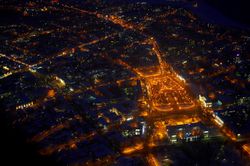 Irkutsk at night |
|
.svg.png) Location of Irkutsk Oblast in Russia |
|
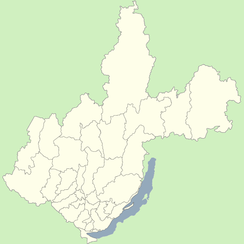 Irkutsk
|
|
| Coordinates: | |
 |
.png) |
| City Day | First Sunday of June |
| Administrative status | |
| Country | Russia |
| Federal subject | Irkutsk Oblast |
| Administrative center of | Irkutsk Oblast, Irkutsky District |
| Municipal status | |
| Urban okrug | Irkutsk Urban Okrug |
| Mayor | Viktor Kondrashov |
| Representative body | Duma |
| Statistics | |
| Population (2002 Census) | 593,604 inhabitants[1] |
| - Rank | 24th |
| Time zone | IRKT/IRKST (UTC+8/+9) |
| Founded | 1661 |
| Postal code(s) | 664xxx |
| Dialing code(s) | +7 3952[1] |
| Official website | |
Irkutsk (Russian: Ирку́тск; Buryat: Эрхүү Erkhüü) is one of the largest cities in Siberia and the administrative center of Irkutsk Oblast, situated 5,185 kilometers (3,222 mi) by rail from Moscow. Population: 593,604 (2002 Census);[1] 622,301 (1989 Census).[2]
Contents |
History
Irkutsk grew out of the winter quarters established (1652) by Yakov Pokhabov for gold-trading and for the collection of the fur tax from the Buryats. The town gained official city rights from the government in 1686. The first road connection between Moscow and Irkutsk, the Siberian Road (Сибирский Тракт, Sibirsky Trakt), was built in 1760. The city benefitted economically from this new road. Many new products, often imported from China via Kyakhta, were widely available in Irkutsk for the first time, including gold, diamonds, furs, wood, silk and tea. In 1821, as part of the Speransky reforms, Siberia was administratively divided at the Yenisei River and Irkutsk became the seat of the Governor-General of East Siberia.

In the early 19th century, many Russian artists, officers, and nobles were sent into exile to Siberia for their part in the Decembrist revolt against Tsar Nicholas I. Irkutsk became the major centre of intellectual and social life for these exiles, and much of the city's cultural heritage comes from them; many of their wooden houses, adorned with ornate, hand-carved decorations, survive today in stark contrast with the standard Soviet apartment blocks that surround them. By the end of the 19th century there was one exiled man per two locals. Different people from the members of the Decemberists' uprising to Bolsheviks have been staying in Irkutsk for a long time. These people have greatly influenced the culture and the development of the city and it has finally became a prosperous cultural and educational centre for Eastern Siberia.
1879, on July 4 and 6, the palace of the (then) Governor General, the principal administrative and municipal offices and many of the other public buildings were destroyed by fire; and the government archives, the library and the museum of the Siberian section of the Russian Geographical Society were utterly ruined. Three quarters of the city were destroyed, including approximately four thousand houses. However, the city quickly rebounded, with electricity arriving in 1896, the first theater being built in 1897, and a major train station in 1898. The first train arrived in Irkutsk on August 16 of that year. By 1900, the city had earned the nickname "The Paris of Siberia."

During the Russian Civil War that broke out after the Bolshevik Revolution, Irkutsk became the site of many furious, bloody clashes between the "Whites" and the "Reds". In 1920, Kolchak, the once-feared commander of the largest contingent of anti-Bolshevik forces, was executed there, effectively destroying the anti-Bolshevik resistance.
During the Communist years, the industrialization of Irkutsk, and Siberia in general, was heavily encouraged. The large Irkutsk Reservoir was built on the Angara River between 1950 and 1959 in order to facilitate industrial development.
The Epiphany Cathedral (illustrated, to the right), the governor's palace, a school of medicine, a museum, a military hospital and the crown factories are among the public institutions and buildings. The Alexander Kolchak monument, designed by Vyacheslav Klykov, was unveiled in 2004. On July 27, 2004, the Irkutsk Synagogue (1881) was gutted by a conflagration.
Geography and climate
| Irkutsk | ||||||||||||||||||||||||||||||||||||||||||||||||||||||||||||
|---|---|---|---|---|---|---|---|---|---|---|---|---|---|---|---|---|---|---|---|---|---|---|---|---|---|---|---|---|---|---|---|---|---|---|---|---|---|---|---|---|---|---|---|---|---|---|---|---|---|---|---|---|---|---|---|---|---|---|---|---|
| Climate chart () | ||||||||||||||||||||||||||||||||||||||||||||||||||||||||||||
|
||||||||||||||||||||||||||||||||||||||||||||||||||||||||||||
|
||||||||||||||||||||||||||||||||||||||||||||||||||||||||||||

The city proper lies at the Angara River, a tributary of the Yenisei, 72 kilometers (45 mi) below its outflow from Lake Baikal, and on the bank opposite the suburb of Glaskovsk. The river, which has a breadth of 580 meters (1,903 ft) is crossed by a flying bridge and two other bridges downstream. The Irkut River, from which the town takes its name, is a small river which joins the Angara directly opposite the town. The main portion of the city is separated from several important landmarks—the monastery, the fort, and the port, as well as its suburbs by another tributary, the Ida, or Ushakovka River.
As a Siberian city, Irkutsk experiences a subarctic climate (Köppen climate classification Dwc), characterized by extreme variation of temperatures between seasons. Temperatures can be very warm in the summer, and brutally cold in the winter. However, Lake Baikal takes its effect, such that temperatures in Irkutsk are not as extreme as elsewhere in Siberia. The warmest month of the year in Irkutsk is July, when the mean temperature is 18 °C (64.4 °F), the highest temperature recorded being 37 C. The coldest month of the year is January, when the mean temperature is only −19 °C (−2.2 °F). Precipitation also varies widely throughout the year, with the wettest month also being July, when precipitation averages 119 mm (4.70 in). The driest month is February, when precipitation averages only 7.6 mm (.30 in). Almost all precipitation during the Siberian winter falls as fluffy, low moisture content snow.
Irkutsk is situated in a landscape of rolling hills within the thick taiga, typical of eastern Siberia.
According to the regional plan Irkutsk city will be agglomerated with the satellite industrial towns of Shelekhov and Angarsk to form a metropolitan area with a total population of over one million.
| Climate data for Irkutsk | |||||||||||||
|---|---|---|---|---|---|---|---|---|---|---|---|---|---|
| Month | Jan | Feb | Mar | Apr | May | Jun | Jul | Aug | Sep | Oct | Nov | Dec | Year |
| Record high °C (°F) | 2.3 (36.1) |
10.2 (50.4) |
20.0 (68) |
29.2 (84.6) |
34.5 (94.1) |
35.0 (95) |
37.2 (99) |
34.1 (93.4) |
29.5 (85.1) |
25.6 (78.1) |
14.1 (57.4) |
4.6 (40.3) |
37.2 (99) |
| Average high °C (°F) | -14.8 (5.4) |
-10.5 (13.1) |
-1.7 (28.9) |
7.9 (46.2) |
16.3 (61.3) |
22.6 (72.7) |
24.6 (76.3) |
22.0 (71.6) |
15.3 (59.5) |
7.1 (44.8) |
-4.4 (24.1) |
-12.9 (8.8) |
6.1 (43) |
| Average low °C (°F) | -25.1 (-13.2) |
-23.4 (-10.1) |
-15.8 (3.6) |
-4.8 (23.4) |
1.6 (34.9) |
7.6 (45.7) |
11.4 (52.5) |
9.3 (48.7) |
2.6 (36.7) |
-4.4 (24.1) |
-14.9 (5.2) |
-22.7 (-8.9) |
-6.5 (20.3) |
| Record low °C (°F) | -49.7 (-57.5) |
-44.7 (-48.5) |
-37.3 (-35.1) |
-31.8 (-25.2) |
-14.3 (6.3) |
-6.0 (21.2) |
0.4 (32.7) |
-2.7 (27.1) |
-11.9 (10.6) |
-30.5 (-22.9) |
-40.4 (-40.7) |
-46.3 (-51.3) |
-49.7 (-57.5) |
| Precipitation mm (inches) | 12 (0.47) |
9 (0.35) |
13 (0.51) |
19 (0.75) |
33 (1.3) |
62 (2.44) |
120 (4.72) |
86 (3.39) |
50 (1.97) |
30 (1.18) |
18 (0.71) |
19 (0.75) |
471 (18.54) |
| Source: Pogoda.ru.net[3] | |||||||||||||
Emblem
_(1790).png)
The emblem of Irkutsk features an old symbol of Dauria: a Siberian tiger with a sable in his mouth. When the emblem was devised in 1690, the animal was described as a tiger ("babr", a bookish word of Persian derivation) with a sable in his mouth. This image had been used by the Yakutsk customs office from about 1642. It has its origin in a seal of the Siberia Khanate representing a sable and showcasing the fact that Siberia (or rather Yugra) was the main source of sable fur throughout the Middle Ages. (Actually, the English word "sable" is derived from the Russian "sobol").
By the mid-19th century, the word "babr" had fallen out of common usage, but it was still recorded in the Armorial of the Russian Empire. Furthermore, the tigers became extinct in this part of Siberia. In the 1870s, a high-placed French heraldist with a limited command of Russian assumed that "babr" was a misspelling of "bobr", the Russian word for "beaver", and changed the wording accordingly. This modification engendered a long dispute between the local authorities, who were so confused by the revised description that they started to depict the "babr" as a fabulous animal, half-tiger and half-beaver.
The Soviets abolished the image altogether, but it was restored following the dissolution of the Soviet Union.
Economy
Energy
Irkutsk Hydropower Station was the first cascade hydropower station in the Irkutsk region. The building of the dam was started in 1950 and finished in 1958.
Industry
The most famous large-scale industry in Irkutsk is Irkut (company). Irkut [4] (MICEX:IRKT RTS:IRKT) refers to the Irkutsk Aviation Industrial Association[5], it was setup in 1932 in the Transbaykal region of the Soviet Union. It is best known as being the manufacturer of the Su-30 family of interceptor/ground-attack aircraft. The Russian government is planning to merge Irkut with Ilyushin, Mikoyan, Sukhoi, Tupolev, and Yakovlev as a new company named United Aircraft Building Corporation.[6]
There is Irkutsk Aluminium Smelter which belongs to the Rusal Company.[2]
Transport

Important roads and railways like the Trans-Siberian Highway (Federal M53 and M55 Highways) and Trans-Siberian Railway connect Irkutsk to other regions in Russia and Mongolia. Also, the city is served by the Irkutsk International Airport and the smaller Irkutsk Northwest Airport.
The Federal road and railway to Moscow and Vladivostok pass through the other side of the Angara River from downtown Irkutsk.
Culture
Television and mass media
There are many state and privately owned television stations in Irkutsk, including state IGTRK company http://irkutsk.rfn.ru and private ones http://as.baikal.tv AS Baikal TV, TV company AIST http://www.aisttv.ru, TV company Gorod http://www.gorodtv.ru, and e.g. http://www.vsp.ru VSP newspaper agency. Irkutsk live webcamera inlc. life temperature in city center: http://as.baikal.tv/webcam/
Education
Irkutsk is home to East Siberian Education Academy (since 1909), Irkutsk State University (1918), Irkutsk State Medical University (1918), Baykalsky State University of Economics and Law (since 1932), Irkutsk State Technical University (since 1939), Irkutsk State Academy of Agriculture, Irkutsk State Linguistic University (1948), Irkutsk State Railway Transport University (since 1975), and a number of private colleges: Siberian Institute of Law, Economics and Management (since 1993), Institute of Economics of ISTU (since 1996), and others.
Science
As part of the Siberian Branch of the Russian Academy of Sciences there are nine research institutes located in the Irkutsk Academgorodok suburb: Institute of Geography, Energy Systems Institute, Institute of Geochemistry, Institute of Systems Dynamics and Control Theory, Earth's Crust Institute, solar-terrestrial physics institute, Institute of Chemistry, Institute of Limnology (located on lake Baikal's shore), Institute of Plants Physics, Laser Physics Institute (Branch of the Novosibirsk-based Institute). Apart from SB RAS Research Institutes, there are R&D institutes including GAZPROM R&D Institute (Branch of Moscow-based Institute), Irkutsk Institute of Less-Common and Precious Metals and Diamonds.
Literature
Irkutsk has long been home to the well-known Russian writer Valentin Rasputin; many of his novels and stories take place in the Angara Valley. An essay on the cultural history of Irkutsk (and another one about the nearby Lake Baikal) is included in Rasputin's non-fiction collection Siberia, Siberia, which is also available in English translation.
Museums
The Taltsy Museum (Russian: Тальцы), located on the Angara 47 km south of Irkutsk, is an open-air museum of Siberian traditional architecture. Numerous old wooden buildings from villages in the Angara valley which have been flooded after the construction of the Bratsk Dam and Ust-Ilimsk Dam have been transported to the museum and reassembled there. One of the centerpieces of the collection is a partial recreation of the 17th-century ostrog (fortress) of Ilimsk, which consists of the original Spasskaya Tower and the Church of Our Lady of Kazan transported from the flooded ostrog in the mid-1970s, to which an exact modern copy of another tower of the ostrog and the southern wall of the fortress were added in the early 2000s[7]
Sports
Bandy is a very big sport in the city. There are several clubs, and the best one, Baykal-Energiya[8] in the highest division of Russian Bandy League, can draw spectator crowds of 30 000. It´s also the centre of women´s bandy in Russia with the club Rekord.[3]
Sister cities/Twin Cities
Irkutsk has the following sister/twin city relationships:[9]
 Ulan Bator, Mongolia
Ulan Bator, Mongolia Shenyang, China
Shenyang, China Kanazawa, Japan
Kanazawa, Japan Eugene, U.S.A.
Eugene, U.S.A.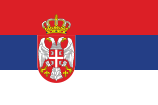 Novi Sad, Serbia
Novi Sad, Serbia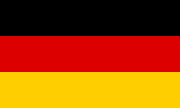 Pforzheim, Germany
Pforzheim, Germany Évian-les-Bains, France
Évian-les-Bains, France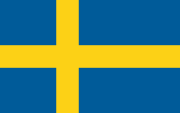 Strömsund, Sweden
Strömsund, Sweden Pordenone, Italy
Pordenone, Italy Grenoble, France
Grenoble, France Dijon, France
Dijon, France
Images gallery
 Location of Irkutsk in southern Siberia |
 A Decembrist house with distinctive hand-carved trim |
 Kazansky Church |
 Irkutsk railway station on the Trans-Siberian Railway |
 Crossing the Angara at Irkutsk (1886) |
References
Notes
- ↑ 1.0 1.1 Федеральная служба государственной статистики (Federal State Statistics Service) (2004-05-21). "Численность населения России, субъектов Российской Федерации в составе федеральных округов, районов, городских поселений, сельских населённых пунктов – районных центров и сельских населённых пунктов с населением 3 тысячи и более человек (Population of Russia, its federal districts, federal subjects, districts, urban localities, rural localities—administrative centers, and rural localities with population of over 3,000)" (in Russian). Всероссийская перепись населения 2002 года (All-Russia Population Census of 2002). Federal State Statistics Service. http://perepis2002.ru/ct/html/TOM_01_04_1.htm. Retrieved 2009-08-19.
- ↑ "Всесоюзная перепись населения 1989 г. Численность наличного населения союзных и автономных республик, автономных областей и округов, краёв, областей, районов, городских поселений и сёл-райцентров. (All Union Population Census of 1989. Present population of union and autonomous republics, autonomous oblasts and okrugs, krais, oblasts, districts, urban settlements, and villages serving as district administrative centers.)" (in Russian). Всесоюзная перепись населения 1989 года (All-Union Population Census of 1989). Demoscope Weekly (website of the Institute of Demographics of the State University—Higher School of Economics. 1989. http://demoscope.ru/weekly/ssp/rus89_reg.php. Retrieved 2007-12-13.
- ↑ 3.0 3.1 "Pogoda.ru.net" (in Russian). http://pogoda.ru.net/climate/30791.htm. Retrieved September 8, 2007.
- ↑ Home page (English)
- ↑ globalsecurity.org entry
- ↑ "Russian Aircraft Industry Seeks Revival Through Merger." The New York Times. February 22, 2006
- ↑ В «Тальцах» завершается реконструкция южной стены Илимского острога (Re-creation of the southern wall of the Ilimsk ostrog in the Taltsy Museum is approaching its completion) (Russian)
- ↑ http://www.baikal-energy.ru/
- ↑ Irkutsk sister cities
Additional sources
 This article incorporates text from a publication now in the public domain: Chisholm, Hugh, ed (1911). Encyclopædia Britannica (Eleventh ed.). Cambridge University Press.
This article incorporates text from a publication now in the public domain: Chisholm, Hugh, ed (1911). Encyclopædia Britannica (Eleventh ed.). Cambridge University Press.
- This article incorporates information from the revision as of 10 July 2006 of the equivalent article on the German Wikipedia.
- Brumfield, William. Irkutsk: Architectural Heritage in Photographs // Moscow: Tri Kvadrata Publishing, 2006. ISBN 9785946070614
- Polunina N.M., Korobov S.A., Sutton J.M., Korobova G.W. Her Majesty — Queen of Siberia // Publishers Korobov. — Irkutsk, 2008.
External links
- Official site of local government (Russian language only)
- Flickr photos tagged irkutsk
- Irkutsk in old and modern photos
- Travel to Irkutsk
- Baikal Club (in English) Articles about lake Baikal by different people from all over the world.
- Irkutsk city architecture views
|
||||||||||||||